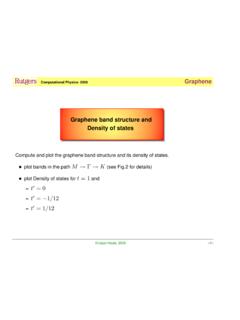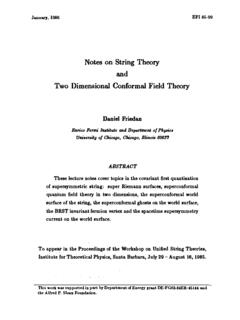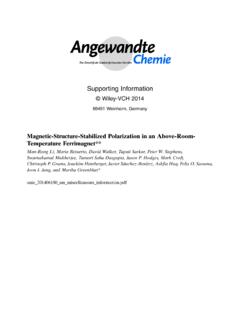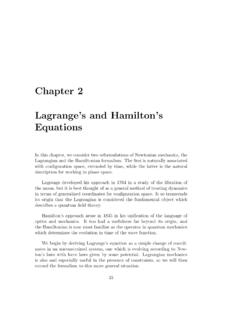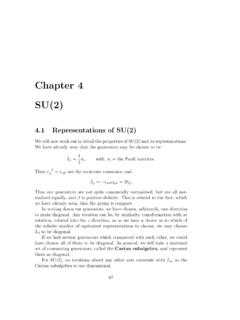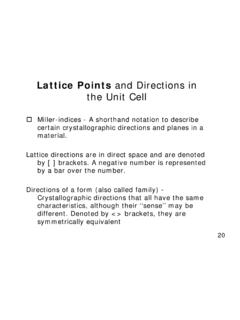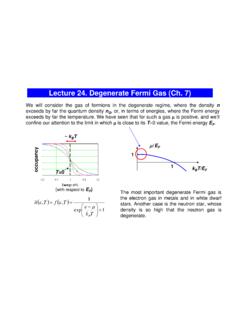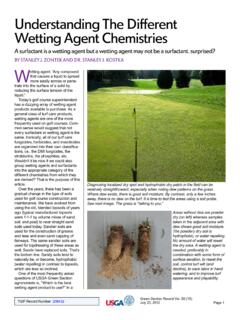Transcription of The Faraday Effect
1 Faraday 1. The Faraday Effect Objective To observe the interaction of light and matter, as modified by the presence of a magnetic field, and to apply the classical theory of matter to the observations. You will measure the Verdet constant for several materials and obtain the value of e/m, the charge to mass ratio for the electron. Equipment Electromagnet (Atomic labs, 0028), magnet power supply (Cencocat. #79551, 50V-5A. DC, 32 & 140 V AC, RU #00048664), gaussmeter (RFL Industries), High Intensity Tungsten Filament Lamp, three interference filters, volt-ammeter (DC), Nicol prisms (2), glass samples (extra dense flint (EDF), light flint (LF), Kigre), sample holder (PVC), HP. 6235A Triple output power supply, HP 34401 Multimeter, Si photodiode detector.
2 I. Introduction If any transparent solid or liquid is placed in a uniform magnetic field, and a beam of plane polarized light is passed through it in the direction parallel to the magnetic lines of force (through holes in the pole shoes of a strong electromagnet), it is found that the transmitted light is still plane polarized, but that the plane of polarization is rotated by an angle proportional to the field intensity. This "optical rotation" is called the Faraday rotation (or Farady Effect ) and differs in an important respect from a similar Effect , called optical activity, occurring in sugar solutions. In a sugar solution, the optical rotation proceeds in the same direction, whichever way the light is directed.
3 In particular, when a beam is reflected back through the solution it emerges with the same polarization as it entered before reflection. In the Faraday Effect , however, the direction of the optical rotation, as viewed when looking into the beam, is reversed when the light traverses the substance opposite to the magnetic field direction; that is, the rotation can be reversed by either changing the field direction or the light direction. Reflected light, having passed twice through the medium, has its plane of polarization rotated by twice the angle observed for single transmission. By placing the sample between two pieces of Polaroid or two Nichol prisms, it can be arranged (with sufficient magnetic field strength) that little light is transmitted through the system in one direction, while it can pass, eventually with undiminished intensity, in the opposite direction.
4 The Effect is unique in this respect: it permits the construction of an irreversible optical instrument with which observer A can see observer B, while A. cannot be seen by B. Read the theory of the Faraday rotation in the appendix and consult the references given at the end of this writeup. Many references can also be found online. The relation between the angle of rotation of the polarization and the magnetic field in the transparent material is given by Becquerel's formula: Faraday 2. 1. = VBd Where the is the angle of rotation, d is the length of the path where the light and magnetic field interact (d is the sample thickness for this experiment), B is the magnetic field component in the direction of the light propagation and V is the Verdet constant for the material (MKS units: radian/Tesla meter).
5 This empirical proportionality constant . varies with wavelength and temperature and is tabulated for various materials. The Verdet Constant, V, depends on the dispersion of the refractive index, dn/d where n is the index of refraction is the wavelength. As shown in the appendix: 1 e dn 2. V = /dB = - 2 m c d . Here e/m is the charge to mass ratio of the electron and c is the speed of light. Some values of V are listed in the table Faraday 3. Substances that are noted for their large dispersion (large dn/d ), such as heavy flint glasses, and CS2, also show a large Faraday Effect as predicted by the theory. In the visible range the refractive index of common substances, such as air, water; lead and soda glasses, etc.
6 , decreases rapidly with increasing wavelength (increasing frequency separation from the governing ultraviolet absorption resonances; normal dispersion);. hence, dn/d is negative and it follows that light traveling in the direction of B has its plane of polarization turned counterclockwise for an observer looking into the beam. The theory discussed in the appendix (cross product expression for magnetic force on a moving charged particle) explains the reversal of the rotation when either the field or the light direction is reversed (but not both). These theoretical conclusions are confirmed by the observations. The fact that the theory predicts the correct sign is a direct proof that the Effect is related to the motion of negative charges , the electrons.
7 With the exception of some paramagnetic materials, the quantitative observations are in excellent agreement with Becquerel's equation. Typically, from = 6 x 10-5 to 7 x 10-5. cm, the refractive index changes by about 10-2. Hence (in mks units) with dn/d 105. e m-1, /c 2x10-15 seconds, and m = , V is therefore about radians per tesla-meter, or minutes of arc per gauss-cm. With a good Nichol prism, rotations of about one-half minute can be observed. Since paths of several centimeters length and fields of a few thousand gauss can be used, the Faraday Effect is quite easy to observe and is measurable with good accuracy. Faraday 4. II. Equipment Filter Sample . Source P olarizer Electromagnet pole pieces Analyzer a.
8 Samples Various glass samples are included with the Faraday Effect attachment: One extra dense flint (marked EDF). One light flint (marked LF). One labeled Kigre. b. Polarimeter and electromagnet Tapered magnet pole tips are used on the electromagnet to concentrate the magnetic field and raise it to as high a value as possible. The pole tips are attached with hollow bolts so that the light may travel through the magnet parallel to the magnetic lines of force. Identical Polaroid filters are mounted with split clamps at the ends of the magnet frame (not Nichol prisms, as indicated in the diagram). These are used as polarizer and analyzer respectively. They have a radial handle for coarse rotation, with dial and vernier scale to measure angle.
9 Fine control is provided by a locking screw and drive screw. Unlock this before coarse angular adjustment. These are identical, so either may serve a polarizer, and the other as analyzer. The fine adjust screws of one has been damaged however, so it is best to use this as the polarizer. Do not change the setting of this during a series of measurements. Anisotropy provides selective absorption in Polaroid material (reference, Serway). Long chain hydrocarbon molecules ( , polyvinyl alcohol) are aligned by stretching during manufacture, and subsequently made conducting along the chains only by dipping into an iodine solution which provides free electrons. Strong, selective absorption of light then occurs for the electric field component in the molecular direction.
10 It follows that the polarizing direction is independent of wavelength, although the degree of polarization (absorption) may not be. The absorption is incomplete, leading to a non-zero constant term in the Malus fit of the vs. analyzer angle data curve. Collimators (plastic washers) have been inserted into the optical path entrance and exit tunnels, to reduce polarization shift by grazing incidence scattering in the magnet Faraday 5. "tunnels". c. Light sources The transparent glass is placed between the pole faces with the plastic support resting on the tapered portion of the pole faces. A high-intensity incandescent lamp with filters is used as a light source. A bright light source is desirable since greater contrast of light levels is helpful in obtaining accurate data.
